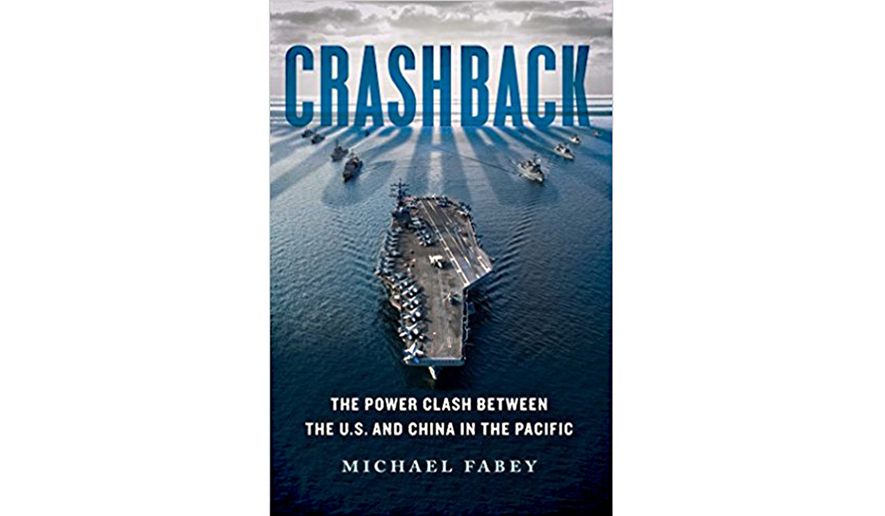OPINION:
CRASHBACK: THE POWER CLASH BETWEEN THE U.S. NAVY AND CHINA IN THE PACIFIC
By Michael Fabey
Scribner, $27, 305 pages
Intelligence analysts and media pundits alike are puzzling whether Xi Jinping, president of China, deserves the recent Economist cover calling him the world’s most powerful man.
Perhaps so. But Michael Fabey’s disturbing new book makes plain that China is now a muscular presence in its part of the world, and with clear ambitions to expand its role.
Mr. Fabey, a veteran defense writer, maintains that China and the U.S. are engaged in a “warm war” for naval dominance in the Pacific that we have “been losing.”
The crux of the crisis is China’s claim of territorial sea rights far beyond those set by international conventions. The issue is complex. For centuries most maritime powers accepted that sovereign territory extended three nautical miles off the shoreline — the range of cannon shot.
After several changes, in 1982 the United Nations formalized “Exclusive Economic Zones (EEZs), which give coastal nations control over sea resources up to 200 nautical miles from its shores. (The U.S. did not sign the treaty, but recognizes EEZs in practice.)
Ignoring the international protocol, China has claimed expanded sea areas by constructing artificial islands as far as 600 miles from its own shores.
The work is centered around the Spratly Islands, 14 sandy outcrops ranging in area from one to 100 acres, spreading the South China Sea.
With Spratly ownership claimed by half a dozen other nations — all closer than China — Peking simply “built” its own island on an outcropping of coral, 14 miles long and four wide, almost completely submerged at high tide.
Chinese engineers dredged up coral and sand to create 86,000 square feet of dry land — enough to accommodate a military airstrip, rocket launchers and support troops. Other such “faux islands” are rising from the sea in the area. Adm. Harry Harris, U.S. naval commander in the Pacific, calls the islands the “Great Wall of Sand.”
Fishing and oil exploration by outsiders are forbidden within EEZs, but the treaty gives the “right of free passage” to all nations during peace. The Chinese, however, claim the rules forbid passage to “military operations,” which includes electronic signals gathering and reconnaissance — which the U.S. has long considered essential to prevent surprise attacks.
The Navy routinely ignores such warnings and insists on asserting its “right of passage” through contested areas. In 2003, the USS Cowpens, a cruiser, was forced to stop dead in the water to avoid ramming an harassing Chinese vessel. (The Navy calls such a stop a “crashback.” Hence Mr. Fabey’s title.)
Perhaps more dangerous is Chinese harassment of U.S. reconnaissance flights, its planes routinely coming within yards of contact. In 2001 a Chinese pilot collided with a U.S. reconnaissance plane. He crashed and died; the American craft made an emergency landing.
But the Chinese are buttressing their navy, building an aircraft carrier (replacing an obsolete ship the Soviets donated years ago) and developing dozens of vessels equipped with missiles.
Fortunately, the U.S. Navy is countering China’s ambitions with new technologies that modernize the missiles that are our dominant sea weapons. And despite the Chinese encroachments, Mr. Fabey’s description of the new weaponry — active and under development — warrants optimism. Some items:
• The electromagnetic rail gun, which uses electricity rather than gunpowder. Magnetic fields created by high electrical currents accelerate a sliding metal conductor between two to launch projectiles at speeds of up to 5,600 mph. The range is over 100 miles. The non-explosive solid projectile, essentially a chunk of steel, has such kinetic energy that “getting hit by one is like being hit by a small asteroid.”
• High-energy laser beams that counter incoming missiles by burning holes in their skins and causing thermal damage to their interiors. Another more powerful laser (30 kilowatts of power, versus 10) “can bore a hole through two inches of steel.” An even more powerful version should disable a battle ship or carrier.
• The Long Range Anti-Ship Missile (LFASM) has an electro-optical terminal seeker which can match a ship’s imagery to a target database. Thus the missile can sort out a target vessel within a well-defended group of enemy vessels. Modifications in the works can propel a thousand pound warhead against a moving vessel at a range of 1,000 miles.
There is much more. Consider the Zumwalt-class destroyer, whose slope-sided superstructure bears close resemblance to the old Confederate ironclad CSS Virginia. Its profile makes the Zumwalt the naval equivalent of a stealth aircraft.
But the ever-present danger: a young pilot, whether American or Chinese, panics during a close-by flight and fires the shot that starts a war.
China’s “wall of sand” is a danger that must not be taken lightly
• Joseph C. Goulden writes frequently on intelligence and military affairs




Please read our comment policy before commenting.